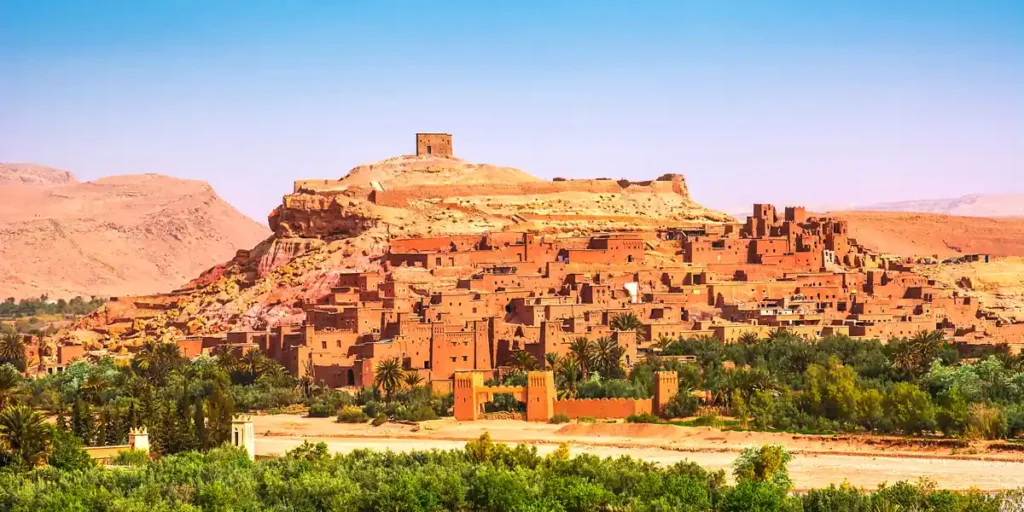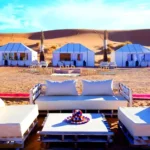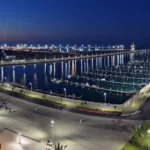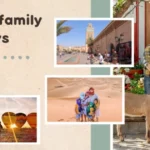Table of Contents
Introduction to Morocco Unesco Sites
Morocco is a country rich in history and culture, boasting nine Morocco Unesco Sites, and World Heritage Sites, each recognized for its outstanding universal value. These sites span diverse categories, from ancient archaeological ruins to bustling medinas and stunning natural landscapes. Let’s delve into the captivating world of Morocco Unesco Sites treasures.
What is a UNESCO World Heritage Site?
Designated by the United Nations Educational, Scientific and Cultural Organization (UNESCO), World Heritage Sites are landmarks or areas of outstanding universal value, encompassing cultural and natural heritage. These sites, deemed to be of exceptional importance to humanity, represent a diverse range of cultural traditions, natural wonders, and historical significance.
To be inscribed on the UNESCO World Heritage List, a site must meet at least one of ten selection criteria, such as representing a masterpiece of human creative genius, exhibiting an exceptional exchange of human values, or containing unique or superlative natural phenomena. Each site undergoes a rigorous evaluation process, ensuring that only those of exceptional value are granted this prestigious designation.
UNESCO World Heritage Sites serve as testaments to humanity’s collective cultural heritage and the wonders of the natural world. They inspire awe, foster understanding, and encourage conservation efforts. These sites, scattered across the globe, represent a shared legacy that transcends borders and unites people through a common appreciation of our planet’s cultural and natural treasures.
Morocco UNESCO Sites:
Morocco Unesco Sites World Heritage showcases the country’s diverse cultural heritage and natural beauty. Let’s explore each of these remarkable sites:
Archeological Site of Volubilis (1997):
Perched amidst the rolling hills of Morocco’s fertile Saïs Plain, the ancient Roman city of Volubilis lies in ruins, a captivating testament to a bygone era. Once a thriving urban center within the Roman province of Mauretania Tingitana, Volubilis’ rich history earned it a place among UNESCO’s prestigious World Heritage Sites in 1997.
As you traverse the sprawling expanse of Volubilis, remnants of a once-bustling metropolis unfold before your eyes. Majestic arches stand proudly, defying the ravages of time, while the foundations of grand temples, opulent villas, and bustling public baths hint at the grandeur that once thrived here. Intricate mosaics, carefully preserved beneath layers of earth, reveal exquisite patterns and scenes depicting the lives of Volubilis’ inhabitants.
Imagine the vibrant energy that once pulsated through these streets, where merchants peddled their wares in bustling marketplaces, citizens gathered in the forum to discuss affairs, and the air resonated with the echoes of daily life. As you explore the ruins of Volubilis, let your imagination transport you back in time, to an era when this city was a beacon of Roman civilization in North Africa.
The city’s origins trace back to the 3rd century BC when Berber tribes established a settlement known as Ouililia. In 40 BC, the Romans seized control of the region, transforming Ouililia into a strategic stronghold and commercial hub. Under Roman rule, Volubilis flourished, becoming a prosperous center of trade and cultural exchange.
Roman influence permeated every aspect of Volubilis, from its architecture and urban planning to its religious practices and cultural norms. Grand temples dedicated to Roman deities, including Jupiter, Juno, and Minerva, dotted the city, while opulent villas reflected the wealth and status of Volubilis’ elite.
As the Roman Empire waned in the 5th century AD, Volubilis’ fortunes declined. Vandal invasions and the rise of local Berber kingdoms gradually eroded the city’s vitality. By the 7th century AD, Volubilis had been largely abandoned, its once-majestic structures gradually succumbing to the elements.
Today, the Archaeological Site of Volubilis stands as a poignant reminder of the ephemeral nature of empires and the enduring power of history. As you wander through the ruins, let your mind reconstruct the vibrant life that once pulsed within these walls, and appreciate the enduring legacy of a city that once played a pivotal role in Roman Africa.
Historic City of Meknes (1996):
Nestled amidst the foothills of the Middle Atlas Mountains, the captivating city of Meknes unveils a rich tapestry of history and culture, earning it a coveted spot among UNESCO’s World Heritage Sites in 1996. Once a flourishing imperial capital during the 17th century, Meknes today stands as a captivating testament to a golden era of Moroccan history.
As you venture into the heart of Meknes, immerse yourself in the labyrinthine medina, a UNESCO World Heritage Site in its own right. This bustling maze of narrow alleyways, adorned with vibrant souks and traditional artisan workshops, beckons you to explore its hidden treasures. Discover local artisans skillfully crafting intricately patterned ceramics, intricate carpets, and gleaming metalwork, each piece embodying the essence of Moroccan craftsmanship.
Step through the monumental Bab el-Mansour, a grand gateway that marks the entrance to the Royal Palace, the former residence of Moulay Ismail, the Alaouite sultan who transformed Meknes into a magnificent imperial city. Admire the exquisite stucco and zellij tilework adorning the palace walls, and imagine the splendor and grandeur that once reigned within its vast courtyards.
Meknes’ architectural heritage extends beyond the Royal Palace, with majestic bastions, imposing city gates, and serene mosques gracing the cityscape. The Moulay Ismail Shrine, with its towering minaret and intricate Azulejo tiles, stands as a testament to the city’s religious significance.
As you wander through Meknes’ enchanting streets, let the city’s rich history come alive. Envision the bustling caravanserai, once bustling with merchants and travelers, the lively workshops where artisans honed their skills, and the lively marketplaces teeming with life.
Beyond its historical treasures, Meknes offers a vibrant cultural scene. Immerse yourself in the city’s traditional music, characterized by rhythmic percussion and soulful melodies. Savor the delectable flavors of Moroccan cuisine, a tantalizing blend of spices and aromas. And immerse yourself in the warm hospitality of the Melanesian people, known for their welcoming spirit and deep-rooted cultural traditions.
Meknes, a city steeped in history and brimming with life, invites you to embark on a journey through time, discover the treasures of a bygone era, and revel in the vibrant spirit of present-day Morocco.
Ksar of Ait ben Haddou (1987):

The Ksar of Ait ben Haddou, a fortified village nestled amidst the dramatic backdrop of the High Atlas Mountains, is a UNESCO World Heritage Site and one of Morocco’s most iconic landmarks. This stunning example of traditional Moroccan earthen architecture has served as a filming location for numerous Hollywood blockbusters, including “Lawrence of Arabia” and “Gladiator.”
The Ksar was built in the 17th century by the Berber Aït Benhaddou tribe, who used it as a trading post and a stronghold against invaders. The village is composed of a maze of narrow alleyways, whitewashed houses, and towering mudbrick walls. The ksar’s most distinctive feature is its iconic agadir, a granary built on top of a tall tower.
The Ksar of Ait ben Haddou is a living village, with a small population of about 800 people. The residents of the ksar still live in traditional Berber homes and practice their traditional way of life. The ksar is a popular tourist destination, and visitors can wander through the village’s narrow alleyways, explore the agadir, and learn about the ksar’s rich history and culture.
The Ksar of Ait ben Haddou is a stunning example of Moroccan architecture and culture. It is a must-see for any visitor to Morocco.
Here are some additional details about the Ksar of Ait ben Haddou:
- The ksar is located in the Ouarzazate province of Morocco, about 200 kilometers from the city of Marrakech.
- The ksar is made of mudbrick, a type of earthen building material that is common in Morocco.
- The ksar’s walls are up to 16 feet thick and can withstand even the strongest winds.
- The ksar is home to a variety of shops, restaurants, and guesthouses.
- The Ksar is a popular filming location for movies and television shows.
The Ksar of Ait ben Haddou is a UNESCO World Heritage Site because it is an outstanding example of traditional Moroccan architecture and culture. It is a living village that is still used by the local community. The Ksar is also a popular tourist destination, and it helps to promote Moroccan culture and tourism.
Medina of Fes (1981):

Step into the labyrinthine heart of Fes, a UNESCO World Heritage Site and one of the oldest and largest medieval cities in the world. With its labyrinthine alleyways, vibrant souks, and captivating historical landmarks, the Medina of Fez invites you on a journey through time, into the soul of Morocco.
Established in 808 AD by Idris I, the Medina of Fez boasts a rich and tumultuous history, having served as the capital of Morocco for centuries. As you wander through its maze of narrow streets, you’ll encounter remnants of bygone eras, from ancient tanneries to majestic mosques and grand palaces.
The Medina of Fez is a sensory overload, a captivating blend of sights, sounds, and aromas. Immerse yourself in the vibrant chaos of the souks, where merchants peddle their wares with infectious enthusiasm. Discover hidden treasures amidst the stalls overflowing with intricately woven carpets, gleaming spices, and traditional handicrafts.
The air is filled with tantalizing scents of Moroccan cuisine, wafting from the bustling eateries that line the alleyways. Indulge in the city’s culinary delights, from savory tagines to sweet pastries, each bite is a symphony of flavors that will tantalize your taste buds.
Beyond its vibrant commerce, the Medina of Fez is home to a wealth of historical and cultural gems. The Al-Karaouine Mosque, founded in 859 AD, stands as one of the oldest universities in the world, its vast courtyards and towering minaret symbolizing the city’s rich intellectual heritage.
Admire the mesmerizing Bab Bou Jeloud, an ornate city gate adorned with intricate zellij tilework, its vibrant colors welcoming you into the heart of the medina. Step into the Nejjarine Museum of Wooden Arts and Crafts, and marvel at the exquisite woodworking traditions that have been passed down through generations of Moroccan artisans.
As you explore the Medina of Fez, don’t hesitate to lose yourself in its labyrinthine alleyways. Unexpected gems await around every corner, from hidden hammams to traditional teahouses, each offering a glimpse into the heart of Moroccan life.
The Medina of Fez is a living, breathing testament to Morocco’s rich heritage and enduring traditions. It’s a place where time seems to stand still, where the echoes of centuries whisper through the narrow streets, and where the vibrant pulse of Moroccan life unfolds before your eyes. Embrace the chaos, immerse yourself in the sensory overload, and let the Medina of Fez captivate your senses and transport you to the heart of Morocco’s captivating soul.
Medina of Essaouira (formerly Mogador) (2001):
Along Morocco’s captivating Atlantic coast, the UNESCO World Heritage Site of Essaouira, formerly known as Mogador, unveils a harmonious blend of Moroccan and European influences. With its 18th-century fortifications, whitewashed architecture, and bustling fishing port, Essaouira exudes a unique charm that has captivated visitors for centuries.
As you venture into the heart of Essaouira’s medina, a UNESCO World Heritage Site in its own right, let the labyrinthine alleyways guide you through a treasure trove of sights and sounds. Discover artisan workshops brimming with handcrafted ceramics, intricate metalwork, and vibrant textiles, each piece embodying the essence of Moroccan craftsmanship.
Admire the enchanting blend of architectural styles that grace the medina’s streets. Whitewashed houses, adorned with blue and green accents, reflect the city’s maritime heritage, while grand archways and ornate stuccowork hint at its European influences.
As you stroll along the ramparts that encircle the medina, soak in the panoramic views of the Atlantic Ocean, where fishing boats bob gently on the waves and the cries of seagulls mingle with the lively pulse of the city below.
Beyond its enchanting medina, Essaouira offers a vibrant cultural scene. Immerse yourself in the city’s traditional music, characterized by rhythmic percussion and soulful melodies. Savor the delectable flavors of Moroccan cuisine, a tantalizing blend of spices and aromas. And engage with the warm hospitality of the Essouairan people, known for their welcoming spirit and deep-rooted cultural traditions.
Whether you’re wandering through the labyrinthine medina, soaking up the sea breeze along the ramparts, or immersing yourself in the city’s vibrant cultural scene, Essaouira invites you to embark on a journey that blends the rich heritage of Morocco with the allure of the Atlantic coast. Let its captivating charm captivate your senses and create memories that will forever linger in your heart.
Portuguese City of Mazagan (El Jadida) (2004):
Nestled along Morocco’s picturesque Atlantic coastline, the Portuguese City of Mazagan, now known as El Jadida, stands as a captivating testament to the country’s rich and intricate history. A UNESCO World Heritage Site since 2004, El Jadida unveils a harmonious blend of Portuguese and Moroccan architectural styles, a legacy of its fascinating past.
Established in 1502 by King Manuel I of Portugal as a strategic stronghold, Mazagan served as a bustling commercial hub and a powerful military outpost. The Portuguese fortified the city with imposing ramparts, grand bastions, and a formidable citadel, transforming it into an impenetrable fortress.
Step through the monumental Bab el-Mansour, an intricate gateway adorned with zellij tilework and Arabic calligraphy, and enter the heart of the Portuguese City of Mazagan. Discover remnants of the city’s Portuguese heritage, from the Manueline-style cistern, an underground reservoir with mesmerizing acoustics, to the ruined church of Saint Sebastian, a poignant reminder of the city’s colonial past.
As you wander through the maze of alleyways in the medina, a UNESCO World Heritage Site in its own right, immerse yourself in the vibrant pulse of Moroccan life. Discover artisan workshops showcasing traditional craftsmanship, bustling souks brimming with colorful wares, and inviting cafes where you can savor the aromatic flavors of Moroccan cuisine.
Beyond its historical treasures, El Jadida offers a captivating coastal ambiance. Stroll along the sandy beaches, soak up the sea breeze, and revel in the refreshing embrace of the Atlantic Ocean. Indulge in fresh seafood delicacies, a testament to the city’s deep-rooted connection to the sea.
El Jadida, a harmonious blend of historical heritage and coastal allure, invites you to embark on a journey through time, where the echoes of the past interweave with the vibrant tapestry of the present. Let its captivating blend of cultures and the allure of the Atlantic coast create memories that will forever linger in your heart.
Medina of Marrakesh (1985):
Step into the intoxicating heart of Marrakesh, a UNESCO World Heritage Site and one of Morocco’s most captivating cities. The Medina of Marrakesh, a labyrinth of narrow alleyways, vibrant souks, and captivating historical landmarks, invites you on a sensory journey through the soul of Morocco.
Established in the 11th century by the Almoravid dynasty, Marrakesh has long been a crossroads of cultures, a melting pot of Berber, Arab, and European influences. As you wander through the medina, a UNESCO World Heritage Site in its own right, you’ll encounter remnants of bygone eras, from ancient tanneries to majestic mosques and grand palaces.
Immerse yourself in the chaotic symphony of the Djemaa el-Fna, a vast square that serves as the city’s pulsating heart. Gawk at snake charmers, acrobats, and storytellers captivating crowds with their traditional performances. Indulge in the tantalizing aromas of street food vendors, their sizzling grills filling the air with irresistible scents.
Venture into the labyrinthine souks, where merchants peddle their wares with infectious enthusiasm. Discover hidden treasures amidst the stalls overflowing with intricately woven carpets, gleaming spices, and traditional handicrafts. Let the vibrant colors and lively atmosphere overwhelm your senses, and embrace the true essence of Moroccan commerce.
Beyond its vibrant souks, the Medina of Marrakesh is home to a wealth of historical and cultural gems. Admire the majestic Koutoubia Mosque, its towering minaret piercing the skyline, a symbol of the city’s enduring faith. Step into the Ben Youssef Madrasa, a 16th-century Islamic school adorned with exquisite zellij tilework and intricate stucco carvings, its tranquil courtyards offering a respite from the medina’s bustling energy.
As you explore the Medina of Marrakesh, don’t hesitate to lose yourself in its labyrinthine alleyways. Unexpected gems await around every corner, from hidden hammams to traditional teahouses, each offering a glimpse into the heart of Moroccan life. Let the medina’s intoxicating aromas, vibrant sights, and captivating sounds captivate your senses and transport you to the heart of Morocco’s soul.
Medina of Tetouan (1997):
Nestled amidst the foothills of the Rif Mountains in northern Morocco, the Medina of Tetouan, a UNESCO World Heritage Site since 1997, unveils a harmonious blend of Andalusian and Moroccan architectural styles. With its whitewashed houses, labyrinthine alleyways, and captivating cultural heritage, Tetouan invites you on a journey through time, into the heart of Morocco’s rich and multifaceted past.
Established in the 14th century by Andalusian refugees fleeing the Christian Reconquista, Tetouan developed into a thriving cultural and commercial center. Its walled medina, a UNESCO World Heritage Site in its own right, stands as a testament to the city’s Andalusian heritage. Wander through the maze of narrow streets, adorned with intricate stuccowork and vibrant zellij tilework, and discover artisan workshops brimming with traditional Moroccan handicrafts.
As you explore the medina, immerse yourself in the vibrant pulse of Moroccan life. Encounter local merchants peddling their wares in bustling souks, their voices intermingling with the lively atmosphere. Savor the tantalizing aromas of freshly baked bread wafting from traditional bakeries, and indulge in the delectable flavors of Moroccan cuisine, a symphony of spices and textures.
Beyond its medina, Tetouan offers a wealth of historical and cultural attractions. Admire the grand Spanish Square, a legacy of the city’s brief Spanish rule in the early 20th century. Step into the Royal Palace, a majestic architectural complex that once served as the residence of the Moroccan sultans. And don’t miss the Hassan II Mosque, a striking modern masterpiece overlooking the Mediterranean Sea.
As you wander through the streets of Tetouan, let the captivating blend of Andalusian and Moroccan influences captivate your senses. Embrace the city’s rich cultural heritage, evident in its architecture, craftsmanship, and cuisine. And savor the warm hospitality of the Tetouani people, known for their welcoming spirit and deep-rooted traditions.
Tetouan, a harmonious blend of historical charm and cultural allure, invites you to embark on a journey through time, where the echoes of the past interweave with the vibrant tapestry of the present. Let its captivating atmosphere create memories that will forever linger in your heart.
Rabat, Modern Capital and Historic City (2012):

Rabat, Morocco’s captivating capital city, has as a UNESCO World Heritage Site since 2012, seamlessly blending its modern urban landscape with its rich historical heritage. As you explore Rabat, let the echoes of ancient civilizations intertwine with the vibrant pulse of a modern metropolis, creating an unforgettable tapestry of cultures and experiences.
Delve into the heart of Rabat’s historical quarter, the UNESCO-listed medina, where labyrinthine alleyways unfold beneath the watchful gaze of towering ramparts. Discover artisan workshops showcasing traditional Moroccan craftsmanship, bustling souks brimming with colorful wares, and serene mosques offering moments of tranquility amidst the city’s vibrant energy.
Admire the Hassan Tower, an unfinished minaret dating back to the 12th century, its towering silhouette symbolizing Rabat’s enduring heritage. Step into the Chellah Necropolis, an ancient Roman city transformed into a serene and evocative archaeological site. And don’t miss the Kasbah of the Udayas, a fortified citadel offering panoramic views of the Atlantic Ocean.
Beyond its historical gems, Rabat embraces modernity with open arms. Stroll along the wide boulevards adorned with lush greenery, where contemporary architecture harmonizes with the city’s historical landmarks. Indulge in the vibrant cultural scene, with art galleries, museums, and theaters showcasing the creative spirit of Rabat’s inhabitants.
As the sun sets, Rabat unveils a captivating nocturnal ambiance. Stroll along the banks of the Bouregreg River, where the twinkling lights of the city reflect on the water’s surface. Savor the delectable flavors of Moroccan cuisine, a symphony of spices and aromas, in one of the city’s many bustling restaurants.
Rabat, a harmonious blend of ancient and modern, invites you to embark on a journey through time, where the echoes of the past interweave with the vibrant tapestry of the present. Let its captivating blend of history, culture, and modernity create memories that will forever linger in your heart.
Possible Future Morocco UNESCO Sites:
Morocco is renowned for its rich cultural heritage and captivating landscapes, making it a treasure trove of potential UNESCO World Heritage Sites. While the country already boasts nine UNESCO-designated sites, several other gems stand poised to join this prestigious list. Here’s a glimpse into some promising contenders for future Morocco Unesco Sites recognition:
- Moulay Idriss Zerhoun: Nestled amidst the Middle Atlas Mountains, Moulay Idriss Zerhoun holds a profound spiritual significance, revered as the birthplace of Idriss I, the founder of the Idrisid dynasty. The town’s ancient mosque, dating back to the 8th century, stands as a testament to its historical importance.
- Taza and the Great Mosque: Situated in the foothills of the Rif Mountains, Taza, a historic city with a rich Berber heritage, is home to the magnificent Great Mosque, an architectural masterpiece dating back to the 12th century. The mosque’s intricate stonework and elaborate courtyard exude an aura of timeless beauty.
- Tinmal Mosque: Perched in the heart of the High Atlas Mountains, the Tinmal Mosque, built in the 12th century, is considered one of the oldest mosques in Morocco. Its traditional earthen architecture and serene atmosphere embody the spiritual essence of Moroccan Islam.
- City of Lixus: Along Morocco’s northern coastline, the ancient Phoenician city of Lixus offers a captivating glimpse into Morocco’s rich archaeological heritage. Excavations have unearthed remnants of temples, public baths, and a necropolis, revealing the city’s former grandeur.
- El Gour (Souk el Jemaa el Gour): In the heart of the Sahara Desert, El Gour stands as a remarkable example of traditional Saharan architecture. This fortified village, constructed entirely of mudbrick, showcases the ingenuity and resilience of communities adapting to the desert environment.
- Cave of Taforalt: Renowned for its paleontological and archaeological significance, the Cave of Taforalt, located in the eastern Rif Mountains, has yielded fossils dating back to the Middle Pleistocene era, providing insights into human evolution and past environments.
- Talassemtane National Park: Nestled in the Rif Mountains, Talassemtane National Park is a haven of biodiversity, home to endangered flora and fauna, including Barbary macaques and unique plant species. Its rugged landscapes and stunning sceneries offer a compelling natural treasure.
- Area of the Dragonnier Ajgal: In the Canary Islands archipelago, the Dragonnier Ajgal, an ancient and revered Dragonnier tree, stands as a natural monument symbolizing resilience and longevity. Its presence adds to the region’s ecological and cultural significance.
- Lagoon of Khenifiss: Along Morocco’s Atlantic coast, the Lagoon of Khenifiss is a serene wetland ecosystem supporting a diverse array of migratory birds and other wildlife. Its peaceful ambiance and abundance of life make it a haven for nature enthusiasts.
- Dakhla National Park: Situated in the Western Sahara region, Dakhla National Park is a coastal paradise renowned for its vast turquoise lagoon, abundant marine life, and opportunities for kitesurfing, windsurfing, and other water sports.
These promising sites, each with its unique allure, have the potential to enrich Morocco Unesco Sites portfolio, further showcasing the country’s rich cultural and natural heritage. As international recognition grows, these gems will continue to captivate visitors and serve as testaments to Morocco’s enduring legacy.
Conclusion to Morocco Unesco Sites
Morocco is home to a rich cultural and natural heritage, reflected in its 9 UNESCO World Heritage Sites. These sites showcase the country’s diverse history, from ancient cities and architectural marvels to unique landscapes. Notable sites include the historic city of Marrakech, known for its vibrant souks and the iconic Jemaa el-Fnaa square, and the ancient Roman ruins of Volubilis, which offer a glimpse into Morocco’s Roman past. The Kasbah of Ait Benhaddou, a fortified city made of clay, is another remarkable site that has appeared in several films. The Medina of Fez and the archaeological site of Ujda further highlight Morocco’s deep cultural roots. Additionally, the natural beauty of sites like the Atlas Mountains and the Argan tree biosphere reserves underline Morocco’s environmental importance. These Morocco Unesco Sites not only preserve the country’s heritage but also attract millions of visitors, contributing to cultural exchange and sustainable tourism.







